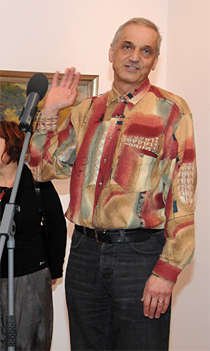
Architect David Vávra celebrates 65 years, loyal to his native Dobeška the whole time
 |
"I have never moved; I still live in the same house," said the tireless promoter of Czech architecture, who has discovered many little-known and forgotten creators for many of her enthusiasts. The house in which the Vávra family lives was purchased by David’s great-grandfather. "He paid for it and designed it for his sister, my grandmother," he stated.
The builder Václav Šindelář contributed to the establishment of Dobeška. "Maybe he went there for vacation like my great-grandfather. My great-grandfather lived near Mánes, he had an apartment and a store in Myslíkova Street, then the largest electrical store in Bohemia. And he traveled to Bráník for vacation by steamboat," Vávra describes the family history.
Builder Šindelář liked Dobeška; he subdivided the area and made a zoning plan for it. "He was enlightened and established the rule that every new house must be designed only by someone who has the authorization, i.e., an architect or builder. Therefore, the original houses created a strong structure, and no new building, however contentious it may be, can disrupt it," he believes.
He himself found the architecture of Šindelář's houses to be outdated, too romantic, but with age and how the original houses can age and few dare to fundamentally change them during renovations, he came to appreciate Šindelář's contribution and the strength of the architecture of the original buildings. But even in Dobeška, there are those who will demolish an old house and build a new one. However, according to Vávra, this will not disrupt the structure of the district due to the aforementioned.
Last year, David Vávra celebrated 50 years of Divadlo Sklep with his friends, which originated from improvised performances and parties of fourteen-year-old classmates in the early 70s. They began playing in the then cultural house Dobeška in 1980, and it later became their home stage. During last year's celebrations, Vávra gave a lecture about Šindelář in Dobeška and agreed with the authors of the book Šindelářova Dobeška that he would write an introduction for it. The book Šindelářova Dobeška was written by Pavel Procházka and Karolína Neuvirtová, the great-granddaughter of builder Václav Šindelář.
While working on the book, she met many eyewitnesses and attempted to capture the origin and development of one Prague district, the fate of individual families and houses, and its founder. The building association for construction in Dobeška was established in 1914, and houses were predominantly built until 1938, with more added after the war. Šindelář was also involved in the repairs of the walls at Vyšehrad, the construction of the swimming stadium under Barrandov, he was the main builder of today’s Institute for the Care of Mother and Child, and he built the Branické Theatre for local amateurs in 1924 and 1925.
The English translation is powered by AI tool. Switch to Czech to view the original text source.
0 comments
add comment
Related articles
0
05.12.2018 | Architectural Ten Commandments by David Vávra
0
15.03.2017 | David Vávra: Running with Houses - Exhibition Opening and Catalog Launch
0
09.03.2017 | David Vávra gifted himself a new book for his 60th birthday
0
06.03.2017 | David Vávra - a professional architect and a great dreamer at heart
0
26.02.2013 | Kolín opened a city gallery designed by David Vávra
0
19.09.2012 | Kolín will build a city gallery according to the design of David Vávra
9
07.03.2007 | Multifunctional David Vávra is enchanted by almost everything












